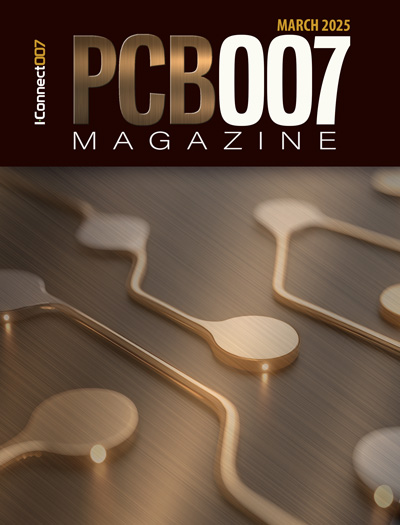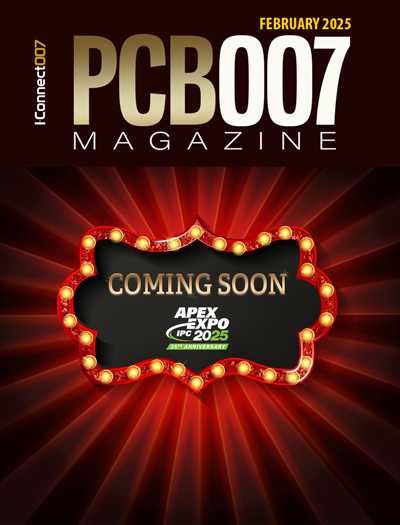-

- News
- Books
Featured Books
- pcb007 Magazine
Latest Issues
Current Issue
Voices of the Industry
We take the pulse of the PCB industry by sharing insights from leading fabricators and suppliers in this month's issue. We've gathered their thoughts on the new U.S. administration, spending, the war in Ukraine, and their most pressing needs. It’s an eye-opening and enlightening look behind the curtain.

The Essential Guide to Surface Finishes
We go back to basics this month with a recount of a little history, and look forward to addressing the many challenges that high density, high frequency, adhesion, SI, and corrosion concerns for harsh environments bring to the fore. We compare and contrast surface finishes by type and application, take a hard look at the many iterations of gold plating, and address palladium as a surface finish.

It's Show Time!
In this month’s issue of PCB007 Magazine we reimagine the possibilities featuring stories all about IPC APEX EXPO 2025—covering what to look forward to, and what you don’t want to miss.
- Articles
- Columns
Search Console
- Links
- Media kit
||| MENU - pcb007 Magazine
Time, Space, Structure, and Model Analysis of CCL Price Increase
April 19, 2021 | Hu Yang, Zhongtai Securities Research CenterEstimated reading time: 1 minute
Editor's note: The price of copper clad laminate (CCL) affects the whole electronics industry. Here, we invited analysts from Zhongtai Securities to analyze and forecast the current situation. The content of this article is also based on field research data of Zhongtai Securities and its researchers. This article originally appeared in PCB007 China Magazine and has been translated from the original Mandarin.
Material prices remain firm and the supply-demand structure has improved. These are the core driving forces of the current round of price increases.
Raw materials account for more than 80% of the cost, and the profit is greatly affected by the material cost.
According to the CCL Association, copper foil accounts for the largest proportion of raw materials (traditional CCL uses epoxy resin, glass fiber cloth and copper as raw materials). Copper foil in thin plate accounts for about 30% of the overall cost; in thick plate copper accounts for 50%. In CCL production, using Shengyi Technology and Chaohua Technology as examples, the cost of raw materials accounts for about 88% of the total cost, with labor accounting for about 4%. Other costs such as equipment depreciation account for about 8%.
The industry chain has strong bargaining power.
The CCL industry has a high entry threshold. Because of the various raw materials, precision, structure, and different production processes, suppliers need to have a higher level of technology to meet the high level of product requirements. In addition, copper clad laminate production requires higher capital expenditure, which also brings significant capital barriers. But this combination strengthens the industry as a whole. According to a Prismark ranking of global rigid copper clad laminate companies, the ranking and market share changed little in recent years, with CR10 accounting for about 70% of total market share in 2019. This gives them strong bargaining power in the industrial chain.
PCB manufacturers are not overly sensitive to price, and customers generally pay more attention to product quality, technical content, and supply stability than pricing. As a result, the PCB customers are more stable in the eyes of the suppliers, owing to the constant strength of the leading companies.
To read this entire article, which appeared in the April 2021 issue of PCB007 Magazine, click here.
Suggested Items
Elephantech: For a Greener Tomorrow
04/16/2025 | Marcy LaRont, PCB007 MagazineNobuhiko Okamoto is the global sales and marketing manager for Elephantech Inc., a Japanese startup with a vision to make electronics more sustainable. The company is developing a metal inkjet technology that can print directly on the substrate and then give it a copper thickness by plating. In this interview, he discusses this novel technology's environmental advantages, as well as its potential benefits for the PCB manufacturing and semiconductor packaging segments.
Trouble in Your Tank: Organic Addition Agents in Electrolytic Copper Plating
04/15/2025 | Michael Carano -- Column: Trouble in Your TankThere are numerous factors at play in the science of electroplating or, as most often called, electrolytic plating. One critical element is the use of organic addition agents and their role in copper plating. The function and use of these chemical compounds will be explored in more detail.
IDTechEx Highlights Recyclable Materials for PCBs
04/10/2025 | IDTechExConventional printed circuit board (PCB) manufacturing is wasteful, harmful to the environment and energy intensive. This can be mitigated by the implementation of new recyclable materials and technologies, which have the potential to revolutionize electronics manufacturing.
Connect the Dots: Stop Killing Your Yield—The Hidden Cost of Design Oversights
04/03/2025 | Matt Stevenson -- Column: Connect the DotsI’ve been in this industry long enough to recognize red flags in PCB designs. When designers send over PCBs that look great on the computer screen but have hidden flaws, it can lead to manufacturing problems. I have seen this happen too often: manufacturing delays, yield losses, and designers asking, “Why didn’t anyone tell me sooner?” Here’s the thing: Minor design improvements can greatly impact manufacturing yield, and design oversights can lead to expensive bottlenecks. Here’s how to find the hidden flaws in a design and avoid disaster.
Real Time with... IPC APEX EXPO 2025: Tariffs and Supply Chains in U.S. Electronics Manufacturing
04/01/2025 | Real Time with...IPC APEX EXPOChris Mitchell, VP of Global Government Relations for IPC, discusses IPC's concerns about tariffs on copper and their impact on U.S. electronics manufacturing. He emphasizes the complexity of supply chains and the need for policymakers to understand their effects.


